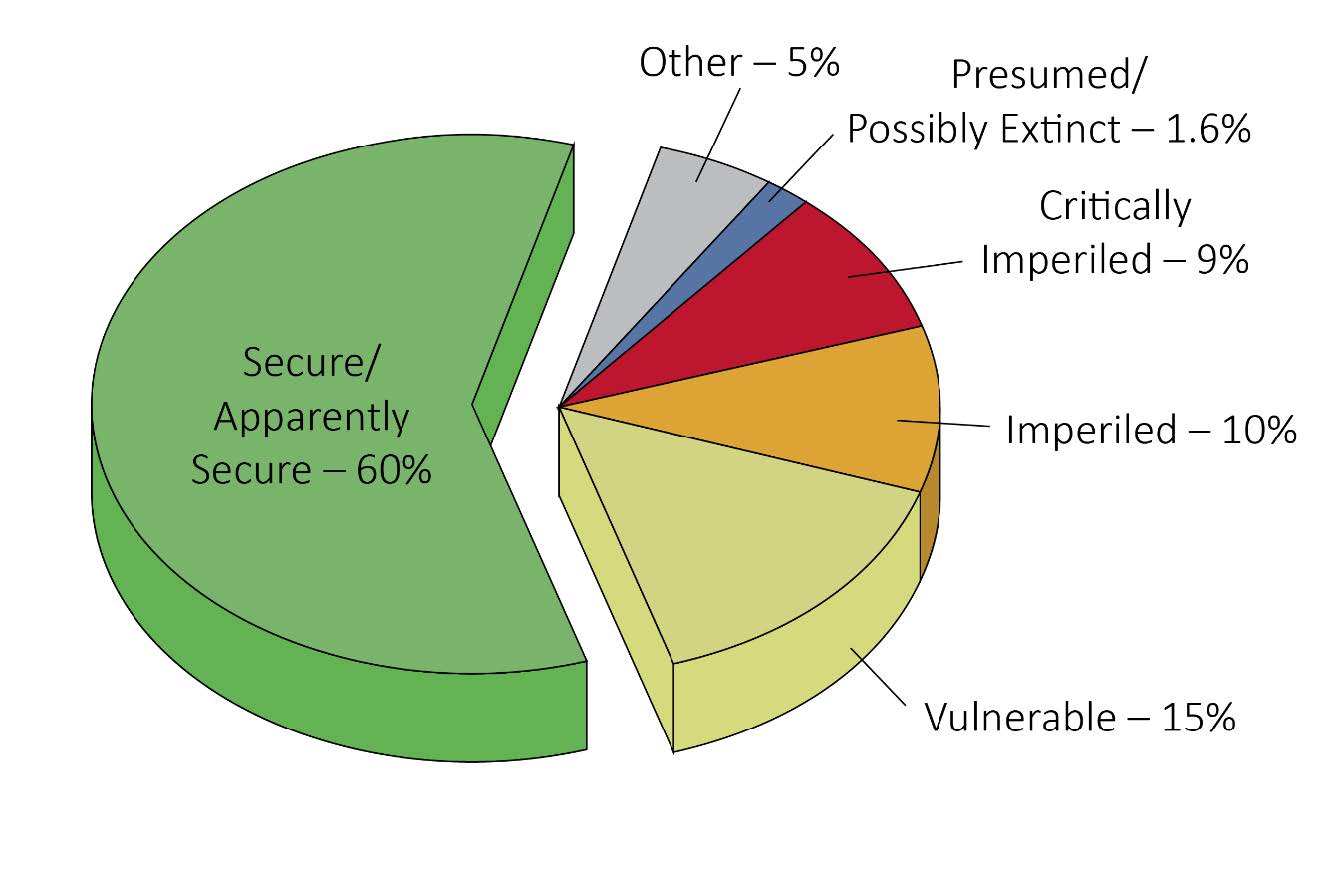NatureServe is a public-private partnership that serves as a clearinghouse for scientific information about the condition and location of the nation’s species and ecosystems, with a particular focus on those that are rare or otherwise of conservation concern. NatureServe in collaboration with its network programs operating across North America including in each U.S. state (NatureServe Network) assess the conservation status of species based on about a dozen factors that relate to increases in extinction risk. These assessments are designed to categorize species into one of five “conservation status ranks,” ranging from critically imperiled (G1) to secure (G5) (Table 1.2).6 Because the status of species may vary from place to place, assessments are carried out at a rangewide scale (where “G” indicates global), as well as at the state level (where “S” indicates state or subnational). As an example, the red-cockaded woodpecker is categorized as vulnerable (G3) across its entire range, which stretches from Texas to Maryland. Its status in any particular state, however, may differ from that rangewide status. In North Carolina, for instance, the woodpecker is regarded as imperiled (S2), while in Virginia it is ranked as critically imperiled (S1). Combining rangewide and state-level conservation status ranks offers a powerful tool for placing local conservation priorities into a broader national and global context.
6For a full explanation of NatureServe’s conservation status ranking system, see
https://explorer.natureserve.org/AboutTheData/Statuses.
Table 1.2. NatureServe conservation status ranks

Note: NatureServe assesses status at three geographic levels: “G” indicates global or rangewide; “N” refers to national, and “S” denotes subnational (state or province). For additional information on these status ranks, see https://explorer.natureserve.org/AboutTheData/Statuses.
By assessing the conservation status of every species in the best-known groups of plants and animals, the NatureServe Network has been able to create a comprehensive view of the overall condition of the U.S. flora and fauna. Summarizing status information across 19 plant and animal groups, representing 27,784 individual species, indicates that more than one-third (33.6%) of U.S. species display some level of increased extinction risk (G1 – G3) (Figure 1.2). Of particular concern are the approximately 9% regarded as critically imperiled (G1) and 10% categorized as imperiled (G2). Looking at conservation status across the various groups of plants and animals reveals some striking patterns (Figure 1.3). While considerable conservation attention focuses on the plight of rare birds and mammals, these groups actually have relatively modest levels of imperilment when compared with several of the taxonomic groups dependent on freshwater habitats. Indeed, 76% of freshwater snail species and 65% of freshwater mussels are categorized as vulnerable, imperiled, or already extinct. Flowering plants, however, contain by far the largest number of at-risk species, due both to the large number of species in this group overall (more than 16,000 native species), and the many rare and highly localized plants that occur in different regions.

Figure 1.2. Proportion of U.S. species at elevated risk of extinction. About one-third of U.S. species in taxonomic groups comprehensively assessed by the NatureServe Network exhibit elevated levels of extinction risk (G1 – G3). (Source: NatureServe Network 2021).

Figure 1.3. Conservation status by plant and animal group. Levels of extinction risk vary dramatically among different groups of plants and animals. Numbers (at left of bars) indicate the number of U.S. native species in the taxonomic group while percentages (at right of bars) reflect the proportion that are at risk of extinction (G1 – G3) or already extinct (GX/GH). In general, species groups that rely on aquatic habitats—such as freshwater snails, mussels, and crayfishes—are faring the worst (Source: NatureServe 2021).
At least 173 U.S. species have already been lost to extinction and are categorized by the NatureServe Network as “presumed extinct” (GX) (NatureServe 2021).7 This includes species that were once extremely abundant, such as the passenger pigeon and Carolina parakeet, along with more obscure organisms, like the San Nicolas Island boxthorn (Lycium verrucosum), previously known only from an island that is now part of Naval Base Ventura County. Definitively establishing that a species has gone extinct is a difficult proposition since one must, of necessity, rely on the Page 33 of 293 absence of evidence—which, as former Defense Secretary Donald Rumsfeld famously pointed out, is not the same thing as evidence of absence. As a result, at least 431 U.S. species are categorized by the NatureServe Network as possibly extinct (GH) (NatureServe 2021); most of these species have not been seen in many years and are regarded as “missing in action.”
7As of December 2020. For a recent review of North American plant extinctions, see Knapp et al. 2021.
Next Page: Species of Greatest Conservation Need
Author
Bruce Stein, Ph.D., Chief Scientist and Associate Vice President
National Wildlife Federation
State of the Nation: The Condition of Biodiversity Across the United States Sections
State of the Nation: The Condition of Biodiversity Across the United States
How is America’s Biodiversity Faring?
Endangered Species Act Listings
NatureServe Conservation Status Assessments
